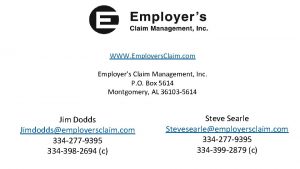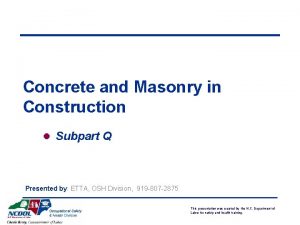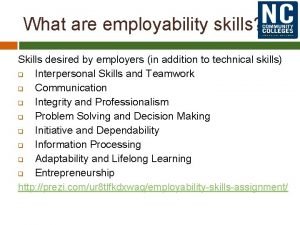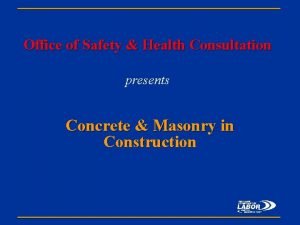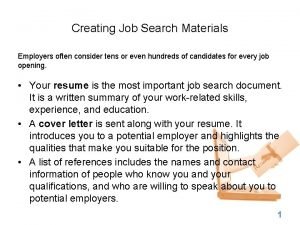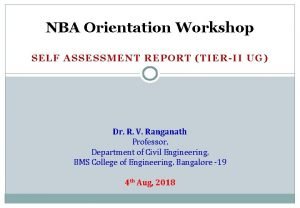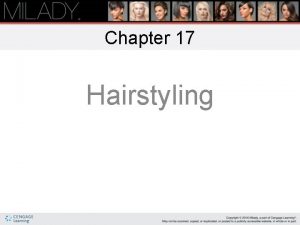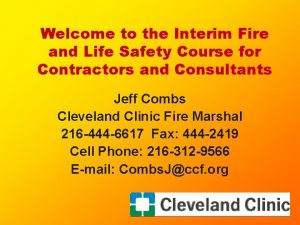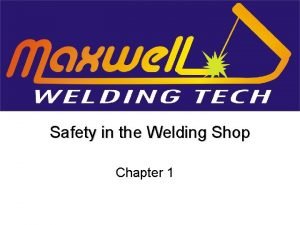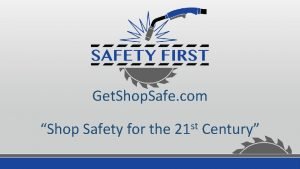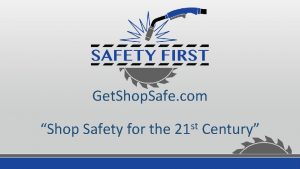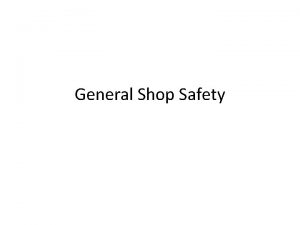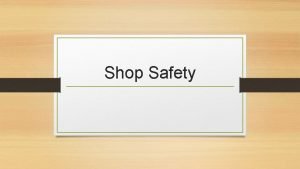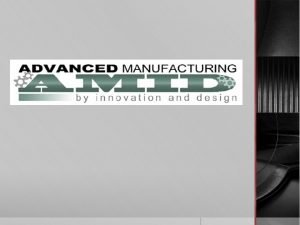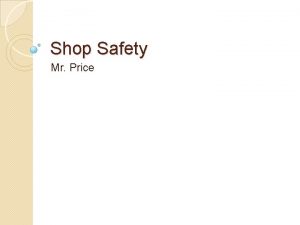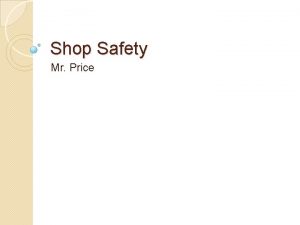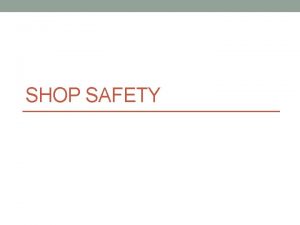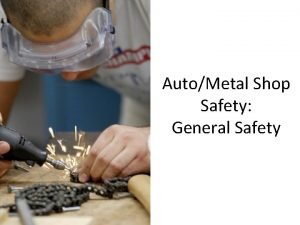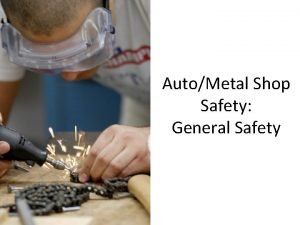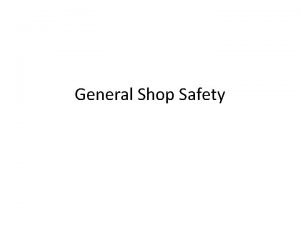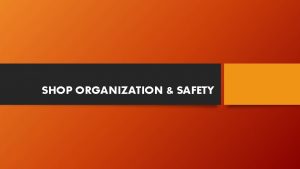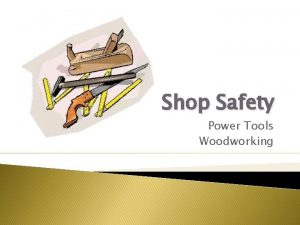Shop Methods Safety Measures for Shop Methods Employers






















- Slides: 22

Shop Methods Safety Measures for Shop Methods

Employers should establish an effective Employee safety program Management must have an active participation in establishing this program: 1. Commitment to the program 2. Communication with employees 3. Train old and new employees 4. Investigate all accidents 5. Evaluate policies to reduce hazardous situations

Establishing an Effective Employee Safety Program 3. Training • All new workers should have an orientation • Train supervisors and workers • Train to recognize hazards • indicate areas of possible injuries • Know where every first aid kit is in the shop • Know what to do in case of an emergency

Personal Protective Equipment • • Head Protection Eye Safety Respiratory Protection Hearing Protection Hand Protection Body Coverings Foot Protection First Aid

Eye Safety You need eye protection when: • Handling caustic chemicals • Working in dust, chaff or other flying particles • Working in the workshop • drilling • grinding • sawing or lathing

Eye Safety (continued) 1. Safety glasses • Can be fitted with prescription and non-prescription lenses • Side shields can be attached to the frames 2. Goggles • Gives front and side protection • Fit over regular glasses 3. Clear plastic face shields • Best protection against • chemical splashes • flying particles • unexpected heavy impacts

Basic Eye First Aid Depends upon the type of injury sustained: • Let natural tears wash out specks in the eye • Don’t rub the eye, if possible 1. Blows to the eye • Apply cold compresses for 15 minutes • Reduce pain and swelling • If discoloration • see a physician

Basic Eye First Aid (continued) 2. Cut and Punctures to the Eye • Bandage the eye lightly • See a physician immediately 3. Chemical Burns to the Eye • Have fresh water available for washing the eyes • continuously flush with water for about 15 minutes • do not use any solutions other than water • See a physician • take the container or label of the chemical involved

Respiratory Protection Type of hazards 1. Particulates 2. Gases 3. Vapors “Respirators must be NIOSH (National Institute of Occupational Safety and Health) approved” “The respirator must be selected for the specific contaminant(s) and it must fit properly”

Particulates Includes particles of solid material and droplets of liquids that can be easily filtered from the air 1. Dusts and mists • Carried on the air for a considerable distance - may be small enough to be carried deep into the lungs - may be toxic and carry bacteria and fungi - common dusts and mists in the shop are * asbestos brake dust * chemical vapors or fumes * welding fumes * exhaust fumes “Mechanical filter respirators approved for toxic dusts and mists provide adequate protection”

Particulates (continued) 2. Asbestos-containing dusts • Harmful - sharp asbestos fibers can penetrate lung cells - lung cancer could result from asbestos exposure - in older buildings - doing renovations “Mechanical filter respirators with approval for asbestos-containing dusts are required” 3. Fumes • Solid particles of burned or evaporated metal - clump together to form smaller particles than dusts and mists “Mechanical filter respirators with approval for fumes must be used”

Gases 1. Toxic gases (one breath can cause instant respiratory arrest and death) • Hydrogen sulfide (manure gas) • Nitrogen dioxide (silo gas) 2. Irritant gases (exposure cause burns and irritation to body tissues) • Ammonia (anhydrous ammonia) 3. Poisonous gases (causes death by asphyxiation, absorbed by blood 200 x more readily than oxygen) • Carbon monoxide “Use only respirators approved for the toxic gases and concentrations that will be encountered”

Common Vapors In the Shop Organic vapors • Solvents “Mechanical filter respirators will trap the particles, but the vapors will still enter the body” • Lacquer thinner • Spray painting • Adhesives • Gasoline “Chemical cartridge respirators must be used to remove vapors from the air” “Cartridges approved for organic vapors are color coded with a black band or label”

Hearing Protection Over exposure to high levels of noise • damage your hearing • aggravates fatigue and stress • major cause of accidents in the shop Noise production in the shop is caused by • • vehicle engines brake lathes welders hammers air tools hoists air compressors

Types of hearing protection 1. Formable plug (a) - compressed prior to insertion, expandable to provide snug fit 2. Premolded plug (b) - flexible material preformed to fit the ear, have a joining cored to prevent loss 3. Earmuffs (c) - adjustable head band with rigid cups and cushions that seal around the ear “Do not use cotton balls, they don’t reduce the damaging sound levels” “If noise can drown out a person speaking to you from arm’s length, you need hearing protection”

Sound intensity is measured in decibels • 85 - 90 decibels (d. B) is the loudest sound that workers should be exposed to for 8 hours or more - should be exposed to less than 90 d. B at any given time - need ear protection

Decibel readings for various types of equipment Examples: • normal conversation 60 • power lawn mower 65 – 95 d. B • doorbell 80 d. B • manual machine, tools 80 d. B • handsaw 85 d. B • electric drill 95 d. B • woodworking class 100 d. B • chainsaw 120 d. B • pneumatic drill 120 d. B

Hand Protection Gloves protects the hands from: • rough or sharp-edged objects • chemicals • dirt • greases • solvents • fuels • paint The best method to protect the hands and prevent dermatitis; thoroughly wash your hands with soap and water and dry them with a single-use towel (if possible)

Type of Gloves 1. Fabric - Inexpensive and suitable for many tasks, breath well, minimizes perspiration buildup - Could be laundered to extend its life - Protects from minor cuts and scrapes 2. Leather - Best choice for protection - Protects from cuts, scrapes, friction and other hazards - Inexpensive, breathable, tough and flexible - Treat with leather care product (mink oil) to extend its life

Type of Gloves (continued) 3. Rubber - Protects from the use of chemicals on the farm, shop, and at home - Choose the appropriate rubber glove material for the task * butyl ………. used to work with gases and vapors * neoprene …. . used to work with chemicals * nitrile ……. . . used to work with solvents, harsh fats, and petroleum - While still on, wash with warm water and soap, hang to dry 4. Cut-resistant - Protects from handling glass and sharp objects

Foot Protection 1. Steel toed safety shoes protects you from: - Sharp objects - Dropped heavy objects - Heavy livestock stepping on your feet 2. Steel toed rubber boots protects you from: - Exposure to hazardous chemicals - Getting your feet wet involving prolonged contact with water

CSA approved safety equipment can be purchase at: 1. Hardware stores 2. Auto Parts stores 3. Safety supply companies 4. Pharmacies 5. Chemical dealers 6. Implement dealerships Check the yellow pages under SAFETY EQUIP & CLOTHING
 Repeated-measures design
Repeated-measures design Job shop organization
Job shop organization Employers claim management
Employers claim management Interview techniques for employers
Interview techniques for employers Forms and shores must not be removed until
Forms and shores must not be removed until Employers must not place construction loads
Employers must not place construction loads Hawaii employers mutual insurance company
Hawaii employers mutual insurance company Skills desired by employers
Skills desired by employers Communication and employability
Communication and employability Federation of european social employers
Federation of european social employers A limited access zone must
A limited access zone must Employer rights
Employer rights A cash flow statement gives you important feedback on your
A cash flow statement gives you important feedback on your Explain why employers often
Explain why employers often Nba sar tier ii
Nba sar tier ii Roller curl stem
Roller curl stem Interim life safety measures examples
Interim life safety measures examples Welding shop safety test
Welding shop safety test Get shop safe .com
Get shop safe .com Getshop safe
Getshop safe General shop safety
General shop safety Ag shop safety
Ag shop safety 10 general shop safety rules
10 general shop safety rules


